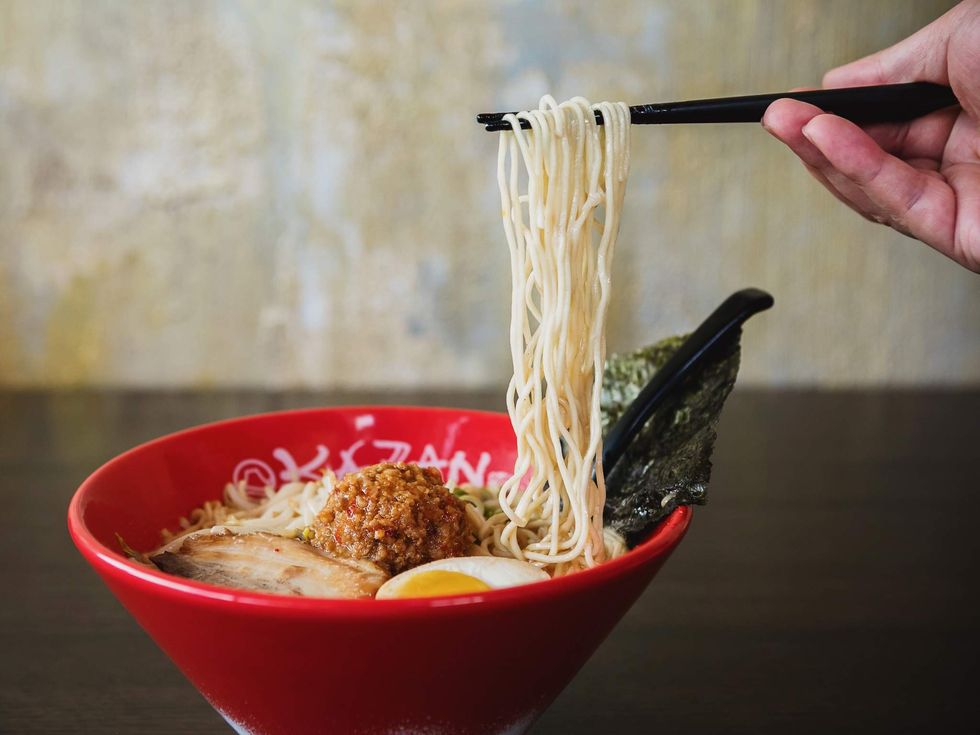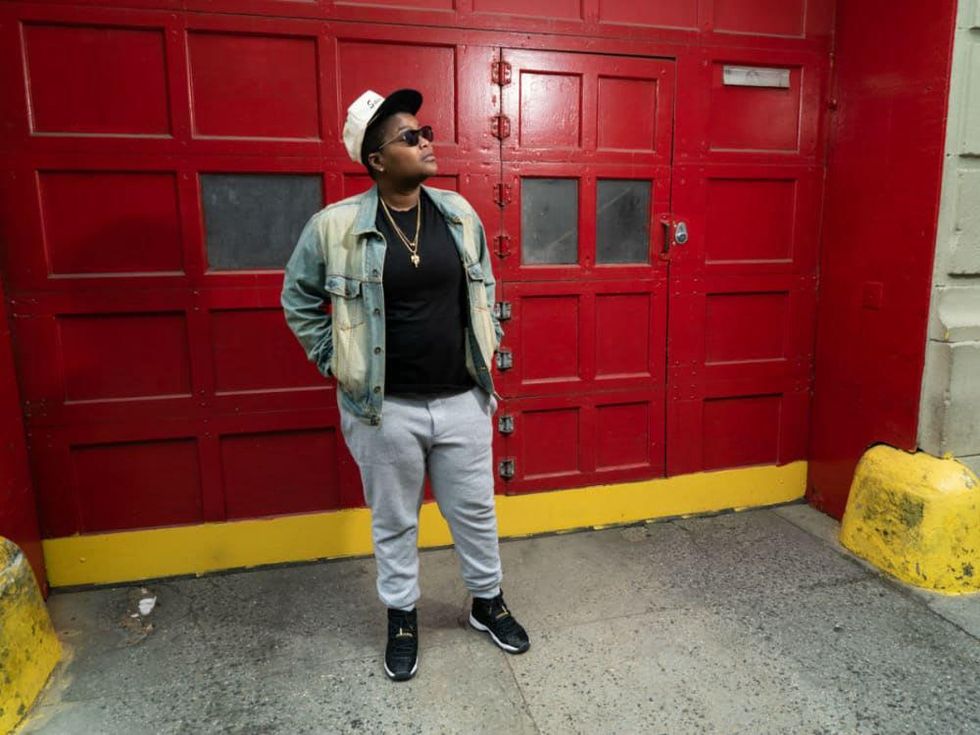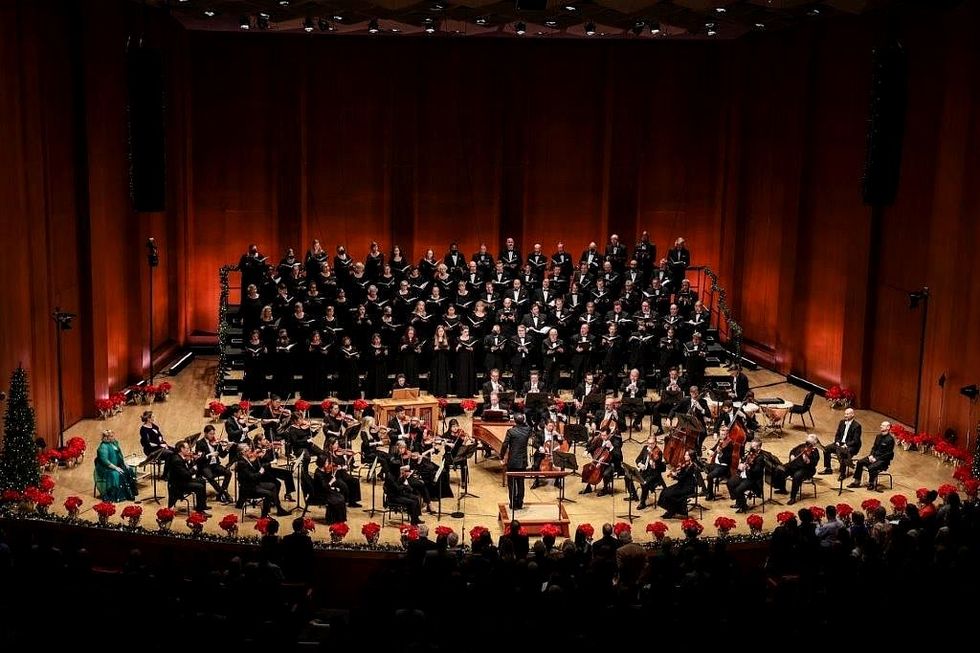The Road to Doha
Gifts that keep on giving: Middle Eastern treasures beckon at MFAH's Gifts ofthe Sultan exhibiit
 India, Shah Jahan Receives the Persian Ambassador, Muhammad 'Ali Beg, folio fromthe Windsor Padshahnama, c. 1633, ink, colors and gold on paper, the RoyalCollection, Windsor
India, Shah Jahan Receives the Persian Ambassador, Muhammad 'Ali Beg, folio fromthe Windsor Padshahnama, c. 1633, ink, colors and gold on paper, the RoyalCollection, Windsor Egypt or Syria, Mosque Lamp, c. 1354–61, enameled and gilded glass, MuseumCalouste Gulbenkian, LisbonPhoto by Catarina Gomes Ferreira
Egypt or Syria, Mosque Lamp, c. 1354–61, enameled and gilded glass, MuseumCalouste Gulbenkian, LisbonPhoto by Catarina Gomes Ferreira Ardabil Carpet, Tabriz, Iran, dated 1539-40 (A.H. 946), silk plain weavefoundation with wool knotted pile, Los Angeles County Museum of Art, gift of J.Paul Getty
Ardabil Carpet, Tabriz, Iran, dated 1539-40 (A.H. 946), silk plain weavefoundation with wool knotted pile, Los Angeles County Museum of Art, gift of J.Paul Getty Ahmed Mater, Saudi, born 1979, Illumination Diptych (Ottoman Waqf), 2010, goldleaf, tea, pomegranate, Dupont Chinese ink and Offset x-ray film print on paper,Los Angeles County Museum of Art, gift of Edge of Arabia and the artist
Ahmed Mater, Saudi, born 1979, Illumination Diptych (Ottoman Waqf), 2010, goldleaf, tea, pomegranate, Dupont Chinese ink and Offset x-ray film print on paper,Los Angeles County Museum of Art, gift of Edge of Arabia and the artist Turkey, Robe of Honor, end of the 17th–first half of the 18th century, silk,silver thread wound around white and yellow silk cores, taqueté weaving(seraser), Museum für Islamische Kunst, Berlin
Turkey, Robe of Honor, end of the 17th–first half of the 18th century, silk,silver thread wound around white and yellow silk cores, taqueté weaving(seraser), Museum für Islamische Kunst, Berlin China, Giraffe with Attendant, 1403–34, ink and colors on silk, mounted as ahanging scroll, Philadelphia Museum of Art, gift of John R. Dorrance
China, Giraffe with Attendant, 1403–34, ink and colors on silk, mounted as ahanging scroll, Philadelphia Museum of Art, gift of John R. Dorrance Syria or Egypt, Pair of Bracelets, 11th century, gold, fabricated from sheet,decorated with wire, granulation and repoussé, Museum of Islamic Art, Doha
Syria or Egypt, Pair of Bracelets, 11th century, gold, fabricated from sheet,decorated with wire, granulation and repoussé, Museum of Islamic Art, Doha
Next stop: Doha.
The Museum of Fine Arts, Houston recently opened its latest show, Gifts of the Sultan: The Art of Giving at the Islamic Courts, which runs through January 16, 2012 and completes its tour in Doha, Qatar. Organized by the Los Angeles County Museum of Art (LACMA), Gifts of the Sultan is, according to MFAH's Islamic art coordinator Francesa Leoni, the "first exhibition organized by Americans to travel to the Middle East."
Gift-giving is a cultural ritual with serious social implications and Gifts of the Sultan makes wonderful and strange such practices of intimate exchange and focuses considerable attention on the varied nature of gift-giving and gifts.
There are gifts for every occasion. We recognize birthdays, weddings, and graduations. We provide tokens of gratitude for hospitality or favors rendered. The exchange of gifts is so common it can be easy to overlook their profundity. The average workplace "Secret Santa" is more than capable of dispelling the mysterious and pervasive power of gift-giving.
Gifts as social currency
"Generosity," Leoni explained, "is a core value of Islamic ethics." As such Gifts of the Sultan offers a unique point of view, a "pan-Islamic exhibition, with items from the 8th to the 19th centuries examined through the lens of gift-giving. Gift-giving is a universal experience but one that held a very special place in Islamic culture."
Gifts of the Sultan explores various kinds of gift-giving, from personal gifts to state (or political) gifts and pious gifts, often referred to as waqf. The "coda" to the show, as Leoni called it, is a series of three works commissioned by LACMA from contemporary artists on the idea of the gift.
The room of personal gifts opens with a signature object, which Leoni describes as "a bowl produced in eastern Iran between the 10th and 11th century, an epigraphic bowl around which is written in floral kufic 'He who believes in recompense from God, is generous with gifts.'"
Not all gifts are lavish, and lavish gifts are not always well- intended.
The bowl was an auspicious start to a room full of enviable gifts — jewelry, boxes once filled with perfumes, textiles, portraits, portraits, and manuscripts — that celebrated weddings, births, royal successions, coming of age ceremonies, circumcisions and more. A particularly opulent pair of bracelets made me wonder for whose arms these were made and if the recipient admired them as much as I did or was inured to such splendor and felt indifferent.
Gifts carry a sense of obligation to those who receive them, as giver and receiver are bound together by sometimes the most slender of objects. I couldn't help but think of this when seeing swatches of fabric that might have becomes robes of state or clothing of other significance.
With so much glittering jewelry and ornamental swords, it's easy to miss some of the real treasures in this exhibit — books, including four folios drawn from the Padshahnama, an epic chronicle of the Mughal Emperor Shah Jahan, who built the Taj Mahal as a memorial to his third wife. Full-page illustrations showcase gift exchange, from the reception of an ambassador to the presentation of a ruby. The manuscript is called the Windsor Padshahnama because it was gifted to George III in 1799 and now remains part of the Royal Collection at Windsor Castle.
As you move from personal gifts to state gifts, the objects remain opulent, but the gravity of the gifts increased noticeably. "The motivations behind the exchange of these gifts," Leoni remarked, "are very very different. State gifts were motivated by strategic reasons."
A gemstone menagerie
Some of the gifts are playful, like a chess board that doubles as a backgammon set and represented a test sent from one ruler to the next. Leoni referred to one whole wall as "the animal wall" because of the frequency of animals as "one of the most prized gifts — either horses or exotic animals that range from giraffes to elephants, rhinos, tigers, etc. So you have quite a wondrous menagerie."
Don't miss the 15th century Ming Dynasty scroll of a "Giraffe with Attendant." It may seem less spectacular than other pieces, but you imagine leading anywhere an animal that towers over you.
They weren't from real animals, I know, but I couldn't take my eyes from a stunning set of 16th- or 17th-century drinking cups, the bowls carved delicately from nephrite and agate, with handles made of sharply detailed golden dragons rearing up as if to take a drink.
Even more impressive was the portrait of Fath Ali Shah, seated with his legs folded under him in a gorgeously textured robe. More informal than an official rendering of the shah in all his regalia and glory, this portrait is one of many instances of an image being sent either to comfort a friend or make anxious an enemy.
Yet again, books played a large role in official political gifts, including images from a polyglot bible gifted to the early Mughal ruler Akbar, who provided a stellar example of interfaith tolerance, as he invited theologians from various religions to speak with one another. The manuscript was a gift from the Jesuits, who played a large role in India after Portugal colonized Goa and other lands. Gift though it was, the Bible was intended as a tool of conversion by rendering biblical scenes in images later glossed in Persian.
Clearly not every gift is a gesture of pure generosity. I was thinking of this especially as I looked through a series of works treating gifts given between Britain and Persia at the beginning of the 19th century. As England consolidated its power in India, France and Russia both showed interest in the territory. As such, Iran became incredibly desirable as a political ally capable of helping block the only land route to India.
Clearly some gifts are self-interested and clearly too the political histories that make the contemporary Middle East so fractious might be traced through some of the gifts on display in Gifts of the Sultan. As Leoni put it, "gift exchange was a vehicle to communicate in subtler ways about power, wealth, and prestige."
A particularly opulent pair of bracelets made me wonder for whose ar ms these were made and if the recipient admired them as much as I did or was inured to such splendor and felt indifferent.
The final room takes up the pious gift, or waqf, which might be understood best as a religious endowment and might impact a variety of buildings from mosques and shrines to madrasahs (schools) and other civic institutions. An array of carpets, shrine coverings, candlesticks, legal documents carefully detailing generous gifts, and rare footage of the Hajj, or religious pilgrimage to Mecca, from the early 20th century. Quite notable is the Ardabil Carpet (1539–40), which rarely travels and which was gifted to the Safavid shrine at Ardabil in northwestern Iran.
Gifts of the Sultan is a veritable compendium of Islamic art, and its focus on the gift as a central node of culture allows the exhibition to create a startling network of images and objects. Some of the most startling are the three commissioned contemporary works in the final room.
In particular don't miss Saudi Arabian artists Ahmed Mater's startling Illumination Diptych (2010), which takes up the idea of a gifted illuminated manuscript. Instead of gorgeously rendered paintings inside elaborate borders, this book inserts two x-ray images of the body on facing pages, looking as if they might be conducting some secret conversation.
What a fitting final image. So much is revealed in the act of giving. Not all gifts are lavish, and lavish gifts are not always well-intended. But Gifts of the Sultan does make one thing clear.
Acts of generosity let us see right through one another.





